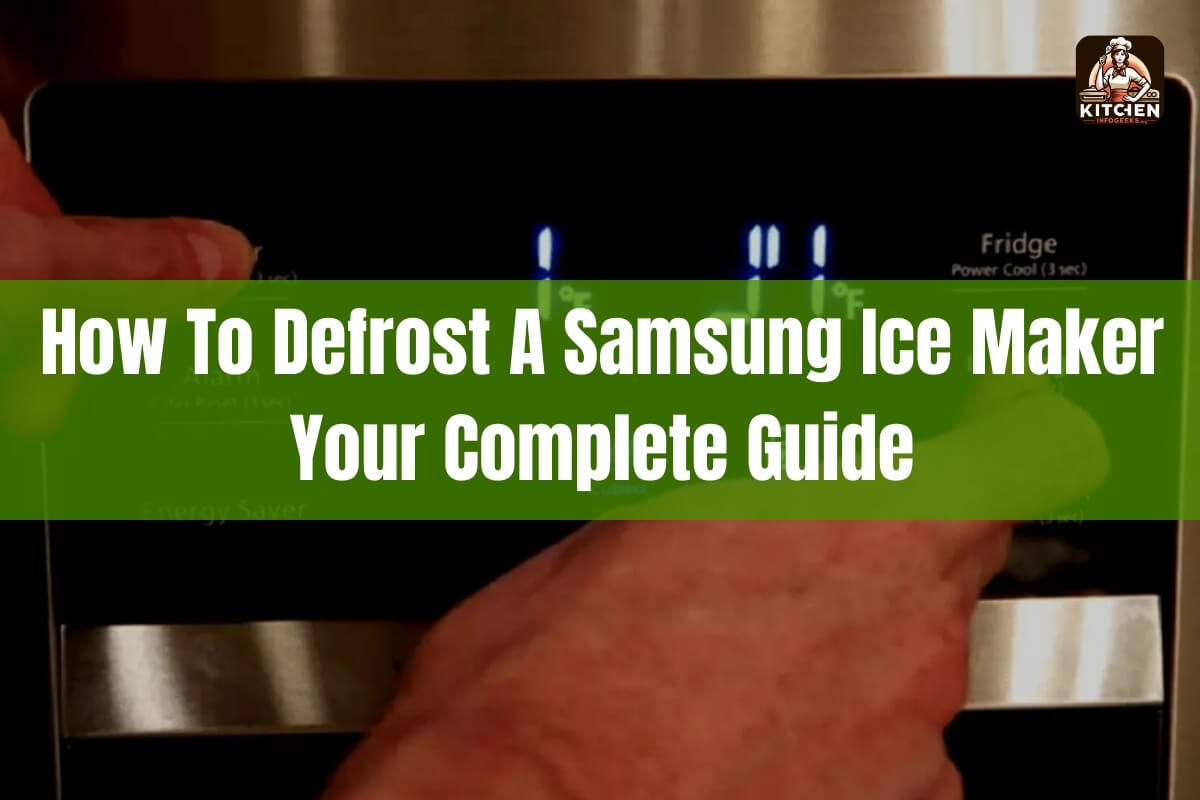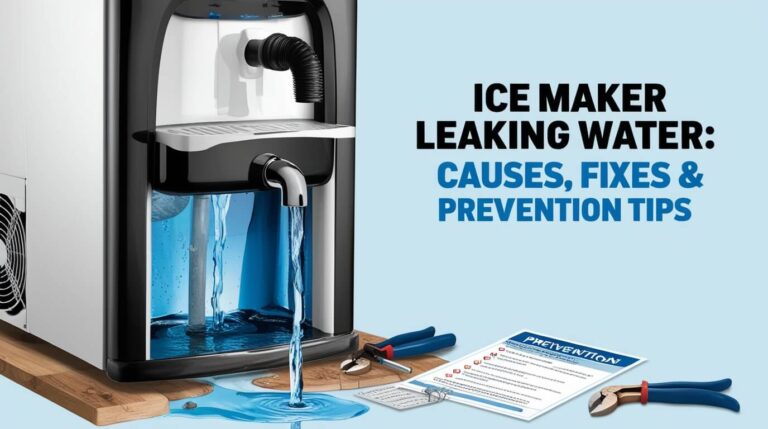
Having trouble with your Samsung ice maker? Ice buildup can prevent it from producing ice cubes, causing frustration when you want a refreshing cold drink. The good news is, you can easily defrost your Samsung ice maker by following a few simple steps. In this post, we’ll walk you through multiple methods to defrost your Samsung ice maker and get it back in working order.
We’ll cover everything you need to know, including:
- Signs that your ice maker requires defrosting
- How to reset or initiate a forced defrost cycle
- Step-by-step instructions for different Samsung fridge models
- Tips to prevent future ice buildup and maintain your ice maker
- Common error codes related to the ice maker
- When to call for professional service
So, let’s dive in and learn how to defrost your Samsung ice maker quickly and efficiently!
Signs Your Samsung Ice Maker Needs Defrosting
Before we get into the defrosting process, it’s important to recognize the signs that your ice maker needs attention. Here are a few telltale indicators:
๐ Visible Ice Buildup: If you notice a thick layer of ice forming inside the ice maker compartment, it’s a clear sign that defrosting is required.
๐ Not Producing Ice: When your ice maker stops churning out fresh ice cubes, ice buildup is likely the culprit and needs to be addressed.
๐ Water Leaking: Ice buildup can cause water to leak from the ice maker, creating a mess in your freezer.
If you spot any of these issues, it’s time to take action and defrost your Samsung ice maker.
Preparing to Defrost
Before you begin the defrosting process, there are a few simple preparation steps to take:
- Remove the Ice Bucket/Tray: Clear out any remaining ice from the bucket or tray to make room for the melting ice during defrosting.
- Have Towels Ready: Keep some towels or rags nearby to catch any water that may drip from the ice maker as it defrosts.
With these quick preparations out of the way, you’re ready to tackle one of the following defrosting methods for your Samsung ice maker.
Method 1: Resetting the Ice Maker
One of the easiest ways to defrost your Samsung ice maker is by resetting it, which initiates a defrost cycle. Here’s how to do it:
- Locate the Reset/Test Button: This button is usually found at the top right or bottom of the ice maker. Consult your user manual if you’re unsure of the location.
- Press and Hold the Button: Press and hold the reset/test button for 5 seconds until you hear a chime or beep.
- Replace the Ice Bucket/Tray: Put the ice bucket or tray back in place to catch any water from the melting ice.
- Wait for Ice Production: Allow 24 hours for the ice maker to complete the defrost cycle and resume ice production.
If the reset method doesn’t solve the issue, move on to the next method: a forced freezer defrost cycle.
Method 2: Forced Freezer Defrost Cycle
A forced freezer defrost cycle is a more aggressive approach to melting ice buildup in your Samsung ice maker. The process varies slightly depending on your specific fridge model, but here are the general steps:
Instructions for Different Samsung Fridge Models
๐ Four Door Flex, Family Hub, and French Door Models:
- Simultaneously press and hold the “Power Freeze” and “Fridge” buttons for 8 seconds until the display goes blank.
- Press any button to cycle through the options until “Fd” (Forced Defrost) appears on the display.
๐ Side-by-Side Models:
- Press and hold the “Freezer” and “Lighting” buttons simultaneously for 8 seconds until the display goes blank.
- Press the “Lighting” button repeatedly until “Fd” is displayed.
Step-by-Step Forced Defrost Process
Once you’ve accessed the forced defrost mode, follow these steps:
- Wait for the Cycle to Complete: The forced defrost cycle typically lasts between 20-60 minutes, during which you may hear beeping sounds.
- Check for Remaining Ice Buildup: After the cycle ends, remove the ice bucket/tray and inspect the ice maker compartment. If you still see ice buildup, you may need to run another forced defrost cycle or try the next method.
- Wipe Down the Ice Maker: Use a clean towel to soak up any excess water or melted ice in the compartment.
- Replace the Ice Bucket/Tray: Return the ice bucket or tray to its position, and your ice maker should now be defrosted and ready to start producing ice again.
Method 3: Full Refrigerator Defrost (If Needed)
In some cases, even after multiple forced defrost cycles, stubborn ice buildup may persist in your Samsung ice maker. If this occurs, you may need to initiate a full refrigerator defrost cycle, which defrosts both the freezer and fridge compartments.
When to Use This Method
Consider a full refrigerator defrost if:
- You’ve run several forced freezer defrost cycles with no success
- The ice buildup seems excessive and widespread
How to Initiate the Cycle
To start a full refrigerator defrost:
- Access the diagnostic mode/interface as you did for the forced freezer defrost.
- Instead of selecting “Fd,” cycle through the options until you see “Rd” (Refrigerator Defrost).
- Select the “Rd” option to begin the full defrost cycle.
Expected Duration
A complete refrigerator defrost cycle can take anywhere from several hours to an entire day, depending on the amount of ice buildup. Be prepared to temporarily store perishable food items in a cooler or alternative fridge during this process.
Preventing Future Ice Buildup
Once your Samsung ice maker is defrosted and functioning properly, you’ll want to take proactive measures to prevent future ice buildup and maintain optimal performance.
๐ Regular Checks and Wipe Downs: Inspect the ice maker compartment weekly and wipe down any frost or condensation buildup with a clean towel.
๐ Periodic Resets/Defrosts: Perform a reset or forced defrost cycle every 3-6 months, even if you don’t notice any issues.
๐ Clean Rubber Seals: Regularly clean the rubber seals on the ice bucket or tray to prevent debris from accumulating and causing ice buildup.
๐ Turn Off When Not in Use: If you won’t be using the ice maker for an extended period, turn it off to prevent unnecessary ice buildup.
By following these simple maintenance tips, you can extend the lifespan of your Samsung ice maker and avoid frustrating defrosting situations.
Common Ice Maker Error Codes
Samsung refrigerators display error codes on the control panel to alert you to potential issues with various components, including the ice maker. Here are some common error codes related to ice maker problems:
- 5E: Fridge defrost sensor error
- 8E and 14E: Ice maker sensor issues
- 33E: Problem with the ice pipe heater
- 39E and 39C: Ice maker function error
- 40E and 40C: Ice maker fan problem
- 84C: Compressor lock issue
If you encounter any of these error codes, refer to your user manual or contact Samsung for further troubleshooting assistance.
When to Call for Professional Service
In some cases, defrosting your Samsung ice maker may not resolve the underlying issue, and professional service may be required. Here are a few signs that it’s time to call in the experts:
๐ Ice Maker Doesn’t Respond: If your ice maker fails to respond to reset attempts or forced defrost cycles, there may be a more significant problem that requires professional diagnosis.
๐ Recurring Ice Buildup: If ice buildup persists and becomes a recurring issue, even after following proper maintenance, it’s time to seek professional help.
๐ Error Codes Persist: If error codes related to the ice maker continue to appear despite your troubleshooting efforts, it’s best to have a technician take a look.
If you find yourself in any of these situations, don’t hesitate to contact Samsung’s customer service at 1-800-SAMSUNG (726-7864) or text “HELP” to 62913. Their knowledgeable team can provide further assistance and schedule a service appointment if necessary.
Conclusion
Defrosting your Samsung ice maker doesn’t have to be a daunting task. By following the step-by-step methods outlined in this guide, you can easily reset or initiate a defrost cycle to clear any ice buildup and get your ice maker back up and running smoothly.
Remember, the key to maintaining a well-functioning Samsung ice maker is regular maintenance. Perform periodic checks, wipe downs, and defrost cycles to prevent excessive ice buildup from occurring in the first place. This proactive approach will not only save you from the hassle of defrosting but also extend the lifespan of your appliance.
If you encounter persistent issues or error codes despite your best efforts, don’t hesitate to reach out to Samsung’s customer service team for professional assistance. Their expert technicians can diagnose and resolve any underlying problems, ensuring your ice maker operates at peak performance.
With this comprehensive guide in hand, you now have the knowledge and tools to tackle ice buildup and keep your Samsung ice maker in top shape. So, the next time you reach for a refreshing ice-cold beverage, you can do so with confidence, knowing that your trusty ice maker is ready to deliver.
Stay cool, and enjoy those perfectly chilled drinks all year round!






